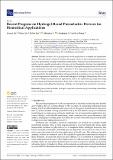Recent Progress on Hydrogel-Based Piezoelectric Devices for Biomedical Applications
Author(s)
Du, Yuxuan; Du, Wenya; Lin, Dabin; Ai, Minghao; Li, Songhang; Zhang, Lin; ... Show more Show less
Downloadmicromachines-14-00167.pdf (6.353Mb)
Publisher with Creative Commons License
Publisher with Creative Commons License
Creative Commons Attribution
Terms of use
Metadata
Show full item recordAbstract
Flexible electronics have great potential in the application of wearable and implantable devices. Through suitable chemical alteration, hydrogels, which are three-dimensional polymeric networks, demonstrate amazing stretchability and flexibility. Hydrogel-based electronics have been widely used in wearable sensing devices because of their biomimetic structure, biocompatibility, and stimuli-responsive electrical properties. Recently, hydrogel-based piezoelectric devices have attracted intensive attention because of the combination of their unique piezoelectric performance and conductive hydrogel configuration. This mini review is to give a summary of this exciting topic with a new insight into the design and strategy of hydrogel-based piezoelectric devices. We first briefly review the representative synthesis methods and strategies of hydrogels. Subsequently, this review provides several promising biomedical applications, such as bio-signal sensing, energy harvesting, wound healing, and ultrasonic stimulation. In the end, we also provide a personal perspective on the future strategies and address the remaining challenges on hydrogel-based piezoelectric electronics.
Date issued
2023-01-09Department
Program in Media Arts and Sciences (Massachusetts Institute of Technology)Publisher
Multidisciplinary Digital Publishing Institute
Citation
Micromachines 14 (1): 167 (2023)
Version: Final published version